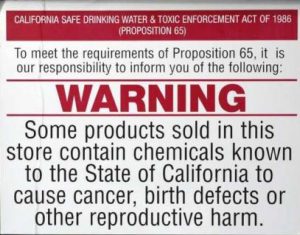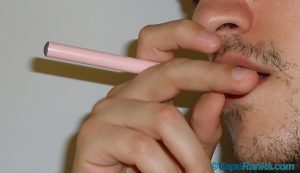Controversial “Study” Claims Most Electronic Cigarettes Release High Levels of Formaldehyde
In a report released late last week, the Center for Environmental Health (CEH) claimed it had tested almost 100 different electronic cigarettes from two dozen manufacturers and found almost all of them release high levels of dangerous gases like formaldehyde and acetaldehyde.
 CEH, a non-profit group based in Oakland, California, apparently carried out an independent laboratory analysis of 97 e-cigarette products and found that most emit higher levels of the two cancer-causing gases than allowed under California’s Proposition 65, the Safe Drinking Water and Toxic Enforcement Act of 1986. “CEH is concerned about the unregulated marketing of e-cigarettes, and especially sales to teens and young people, while little is known about the health hazards from inhaling e-cigarette smoke,” the report stated. In consequence, the organization said it’s taking legal action against e-cigarette makers for not warning customers of this risk.
CEH, a non-profit group based in Oakland, California, apparently carried out an independent laboratory analysis of 97 e-cigarette products and found that most emit higher levels of the two cancer-causing gases than allowed under California’s Proposition 65, the Safe Drinking Water and Toxic Enforcement Act of 1986. “CEH is concerned about the unregulated marketing of e-cigarettes, and especially sales to teens and young people, while little is known about the health hazards from inhaling e-cigarette smoke,” the report stated. In consequence, the organization said it’s taking legal action against e-cigarette makers for not warning customers of this risk.
E-cigarettes have been associated with high levels of formaldehyde before, the most recent case being a controversial study published in January 2015. It was heavily criticized by various scientists, the e-cigarette industry and members of the vaping community for using extreme temperatures to heat and burn the wicks, which would obviously lead to the release of formaldehyde. Everyone agreed that no one would actually vape in these conditions, because the burnt taste would alert the user something was wrong and they would fix it.
However, the CEH report clearly states their research was done using smoking machines designed to replicate how electronic cigarettes are used.
This all sounds like bad news for electronic cigarettes, and it is, but not for the reason you think. Going through the actual report released by the Center for Environmental Health, you soon realize it provides no evidence whatsoever to backup these serious claims, but that hasn’t stopped the media from picking it up and promoting it as a scientific study. The CEO of CEH even went on TV to warn about the dangers of electronic cigarettes, and you can bet a lot of people actually believed what he had to say, even though it’s based on absolutely no sound scientific evidence. As Carl V. Phillips of Anti-THR Lies says “this does not even rise to the level of being junk science — it is non-science, as should be obvious to anyone who reads even the press release,” but the general public doesn’t know that when they read the scary headline on a news website or in a newspaper. That’s why even this kind of unsubstantiated misinformation can do a great deal of harm.
The controversial report doesn’t mention anything about the methodology used to reach the results, which are also unclear, apart from the levels of formaldehyde and acetaldehyde being higher than those allowed under California’s Proposition 65. As Doctor Konstantinos Farsalinos notes on his website, “they do not mention a single sentence on how they performed the testing, they do not mention how ‘realistic conditions of use‘ were defined and they do not mention a single number (amounts of formaldehyde and acetaldehyde found) or how they made the calculations (daily exposure? based on how many puffs per day?).” Gregory Conley, president of AVA Board and a longtime vaping advocate reportedly asked for more details about the methodology used by CEH, but they refused to provide it.
Then there is California’s Proposition 65, a controversial law that requires every building in the state to post warnings when potentially cancer-inducing chemicals are present. The problem is the chemicals are so ubiquitous — the current list contains about 800 chemicals from acetaldehyde to zileuton – that just about every building has one of these warnings. Since 1986 more than 16,000 lawsuits related to Proposition 65 have been filed, resulting in more than $500 million in settlement payments. Shaking down businesses that violate the strict provisions of Proposition 65 has become very profitable for lawyers willing to exploit its flaws.
And who do you think has been the most predatory litigant using Proposition 65 in the last few years? You guessed it, the Center for Environmental Health, which pocketed $2.8 million from 80 settlements totaling $4.1 million, according to a 2013 article on CalWatchdog. Most of their income from the last year reported came from awards from lawsuits and fees. They are now coming after e-cigarette makers… Ironically, tobacco cigarettes do not have to have the California warning about carcinogens or harm to fetuses, thanks to federal preemption. E-cigs, on the other hand, are fair game.
Another thing to take into account is that the California-defined limits for formaldehyde exposure cited by CEH are 40 ug per day. In a recent study published in the Addiction Journal, Dr. Farsalinos found 11.3 ug formaldehyde per 10 puffs under normal vaping conditions (no overheating). That means the California limit would be exceeded by taking just 40 puffs per day… Even the World Health Organization has calculated that the average daily exposure to formaldehyde is 500-1100 ug/day, and by Dr. Farsalinos’ calculations a total daily exposure of 2500 ug is safe.
Considering formaldehyde is naturally formed in the body of every human and is exhaled at levels of 1-10 ug/m3 or even more, you could probably exceed the provisions of Proposition 65 just by breathing…
Basing their case on a useless law that has become famous as a lucrative tool for predatory lawyers and offering no details about the methodology of their “research”, it’s becoming obvious that the Center for Environmental Health has engaged in a media war against electronic cigarettes merely for profit and with little regard to public health.
They are not a problem, but their false message most certainly is. News about their “scientific” report has been circulating online and renowned anti-smoking activisits have already linked to this nonsense and helped spread it on social media. Stanton Glanz and Simon Chapman are just two big names that have chosen to believe the lies without even questioning the way CHE reached their conclusion. Makes you think, doesn’t it?
















